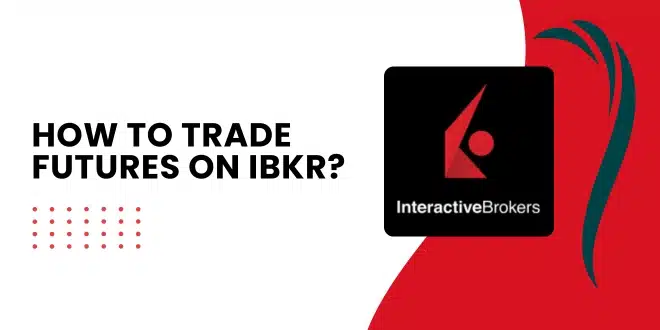Futures trading on Interactive Brokers (IBKR) can seem intimidating at first, especially if you’re new to derivatives. But once you understand the basics and how the platform works, trading futures can become a flexible way to manage risk or explore new opportunities.
This guide walks you through everything — from setting up your account to placing your first trade. It’s built for beginners and cautious intermediates who want to learn carefully, without hype or pressure.
Whether you’re just curious or ready to start, you’ve got this — and you’re not alone.
Quick Overview: 6 Steps to Trade Futures on IBKR
- Open a margin account and request futures permissions
- Fund your account with enough margin capital
- Choose a platform: TWS, Client Portal, or Mobile
- Search and select your futures contract
- Place your buy/sell order with a stop-loss
- Monitor your position and manage risk
What Are Futures and Why Trade Them?
Futures are agreements to buy or sell something at a future date — but you’re not buying the actual asset. You’re trading the contract that tracks the price of that asset.
Common futures include:
- Stock indexes like the S&P 500 or Nasdaq
- Commodities like crude oil or gold
- Bitcoin and currencies
- Treasury bonds and interest rates
Why traders use them:
- To hedge (protect) a portfolio
- To speculate on price moves
- To access leverage more efficiently
- To gain exposure to global markets
Real-world example: Let’s say you think the S&P 500 will rise. Instead of buying the ETF, you buy a Micro E-mini S&P futures contract (MES). You commit less capital and still benefit if the index climbs.
Who Can Trade Futures on IBKR?
Not every account can trade futures automatically. Here’s what you need:
- A margin-enabled IBKR account (not cash-only)
- Futures permissions activated (you apply via settings)
- Sufficient experience — IBKR asks a few questions
- Enough cash to meet margin requirements
Pro Tip: Many users report approval within 24–48 hours. If there’s a delay, IBKR may ask for clarification. Just answer honestly — the review is for your protection.
How to Trade Futures on IBKR: Step-by-Step
Here’s a beginner-friendly walkthrough of how to trade futures successfully using IBKR.
Step 1: Log In and Enable Futures Trading. Open the IBKR Client Portal. Under “Settings,” go to “Trading Permissions,” select “Futures,” and choose the exchanges you want access to.
Step 2: Fund Your Account. Deposit enough to cover the initial margin for your chosen contract. Even small contracts can require several hundred dollars.
Step 3: Choose a Platform
- Client Portal: Easiest for beginners
- TWS (Trader Workstation): Best for advanced tools
- Mobile App: Handy for managing trades on the go
Step 4: Search for a Contract. Use the search bar (e.g., type “MES”) to find contracts. Check expiration date, tick size, and margin details.
Step 5: Place Your Order. Click Buy or Sell, enter quantity, pick market or limit order, and review the margin impact. Add a stop-loss.
Step 6: Monitor the Position. Use charts, alerts, and the activity tab to track your trade. Set goals and don’t let emotions lead your exits.
Futures Trade Flow – Example:
- Search “MES”
- Select June contract
- Check tick size/margin
- Click Buy 1 contract
- Add stop-loss at -$50
- Submit
- Watch and adjust
The “Starter Pack” for New Futures Traders
Want to get started without feeling overwhelmed? Try these 3 beginner-friendly contracts that move slower and require lower capital.
Beginner Futures Starter Pack:
- MES (Micro E-mini S&P 500) – Small version of S&P 500
- MNQ (Micro Nasdaq) – Tech market exposure
- MGC (Micro Gold) – Tracks gold with reduced size
Each of these has a lower margin and a smoother learning curve. Many new traders start with MES to practice without risking large sums.
A Beginner’s First Trade: A Realistic Story
“I watched MES in demo mode for two weeks. One Friday, I funded my account with $1,200 and bought 1 contract. I placed a $40 stop-loss and exited after a $25 gain. It wasn’t life-changing — but it proved I could plan, manage risk, and stay calm. That confidence boost meant everything.”
This is how real traders get started: slowly, intentionally, and with full control.
Understanding Futures Margins on IBKR
IBKR calculates futures margin in real-time. You’ll see two numbers:
- Initial Margin – needed to open the position
- Maintenance Margin – required to keep it open
Margin changes based on:
- The asset’s volatility
- Exchange rules
- Whether you’re holding overnight
Pro Tip: You can check margin requirements before placing any trade. Look for the “Margin Impact” section on your order ticket in TWS or the Client Portal.
Don’t Forget: Expiration and Rollover
Futures contracts expire — and that matters. If you hold a contract past expiration, it may auto-settle, which could create unwanted outcomes.
To avoid that:
- Close the position before expiry
- Roll it by selling the old and buying the next month’s contract
Pro Tip: IBKR sends notifications as contracts near expiration. Set calendar reminders so you’re never caught off guard.
Risk Management Tips for Futures Traders
Futures are powerful — and risky. Here’s how smart traders manage their downside:
- Start with micro contracts and trade 1 lot
- Always use stop-loss and take-profit levels
- Avoid holding overnight until you’re experienced
- Limit yourself to 1–2 trades per day while learning
- Never risk more than 1–2% of your account on a trade
Real insight: Many traders on futures forums say their worst losses happened when they skipped stops or overtraded out of frustration.
Useful IBKR Tools for Futures Traders
Interactive Brokers offers tools that make trading safer and smoother — if you know where to look.
Try these:
- Margin Calculator – shows exact impact before placing trades
- BookTrader (TWS) – fast entry/exit tool with price ladder
- Alerts – get notified when price hits your target
- Futures Market Scanner – find contracts by volume or price movement
Pro Tip: Use IBKR’s Paper Trading Account to practice your futures strategy with zero real money at risk.
How IBKR Compares to Other Futures Brokers
IBKR stands out for:
- Global access to over 30 futures exchanges
- Low commissions and margin rates
- Advanced tools for both new and pro users
- Flexible trading platforms (web, mobile, desktop)
Compared to brokers like NinjaTrader or TradeStation, IBKR is especially strong for those who want multi-asset access and institutional-grade tools at a retail level. It may feel overwhelming at first, but once you learn the system, it’s incredibly powerful.
Final Thoughts
Futures trading might seem complex — but it’s also learnable. Everyone starts somewhere. If you take it slow, trade small, and focus on learning instead of earning, you’ll be ahead of most new traders.
You don’t have to be perfect. You just have to be prepared.
FAQs
1. Can I trade futures with a cash account on IBKR? No, you need a margin-enabled account to access futures trading
2. How much money do I need to start trading futures? Some micro contracts like MES or MNQ can be traded with under $500 in initial margin
3. Do I need special permission to trade futures on IBKR? Yes, enable futures permissions in your settings and complete the required risk acknowledgment
4. What’s the difference between micro and regular futures? Micro contracts are 1/10th the size of standard ones, making them ideal for beginners with smaller accounts
5. Is futures trading safe for beginners? It can be if you start small, use stops, and practice first — but losses can add up fast without good risk control
6. Can I lose more than I deposit? Yes, futures carry unlimited downside in theory — always use a stop-loss and never risk more than you can handle
7. What’s the best platform to use for futures trading on IBKR? Trader Workstation (TWS) offers the most features, but the Client Portal is simpler for newer users
8. Does IBKR charge commissions on futures? Yes, but they’re low — you’ll see the estimated cost before submitting any trade
9. Can I hold a futures contract long-term? Yes, but you’ll need to roll it forward as each one nears expiration; many traders roll monthly
10. What’s the biggest mistake beginners make? Overleveraging and revenge trading after a loss — keep position sizes small and stick to your plan.


